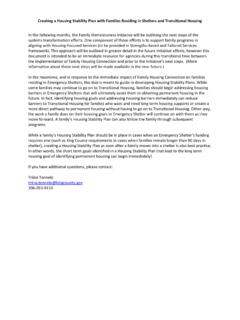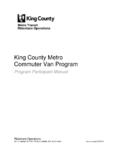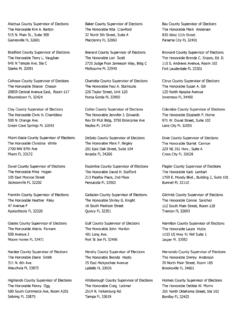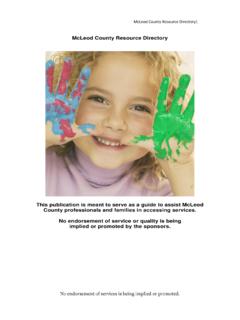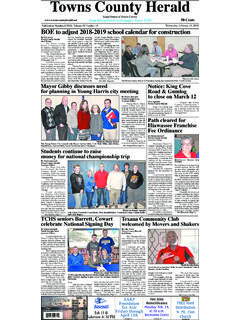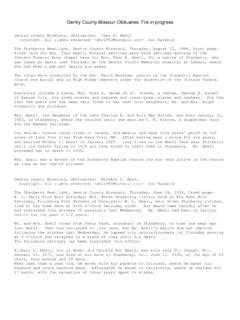Transcription of SEATTLE/KING COUNTY POINT-IN-TIME COUNT OF …
1 COMPREHENSIVE REPORT PRODUCED BY ASRSEATTLE/ king COUNTY POINT-IN-TIME COUNT OF PERSONS EXPERIENCING HOMELESSNESS2018 ABOUT ALL HOME All Home is the lead agency for the SEATTLE/KING COUNTY Continuum of Care. All Home s vision is that homelessness is rare in king COUNTY , racial disparities are eliminated, and if one becomes homeless, it is a brief and only one-time occurrence. Zachary DeWolf Danielle Winslow Sinan Demirel Mark Putnam Jean-Paul Yafali Michelle Valdez Felicia Salcedo Kira Zylstra Triina Van 201 S Jackson Street, Suite 200 Seattle, WA 98104 ABOUT THE RESEARCHER Applied Survey Research (ASR) is a social research firm dedicated to helping people build better communities by collecting meaningful data, facilitating information-based planning, and developing custom strategies. The firm was founded on the principle that community improvement, initiative sustainability, and program success are closely tied to assessment needs, evaluation of community goals, and development of appropriate responses.
2 Applied Survey Research has over 18 years of experience conducting POINT-IN-TIME Counts throughout California and across the nation. Their work is featured as a best practice in HUD s publication: A Guide to Counting Unsheltered Homeless People. Vice President: Peter Connery Department Director: Samantha Green Project Lead: John Connery, Laura Petry Department Coordinator: Jenna Gallant Research Analysts: Javier Salcedo Graphic Design and Layout: Jenna Gallant Central Coast: 55 Penny Lane, Suite 101 Watsonville, CA 95076 tel 831-728-1356 Bay Area: 1871 The Alameda, Suite 180 San Jose, CA 95126 tel 408-247-8319 of Contents 2018 SEATTLE/KING COUNTY COUNT Us In | 3 Table of Contents EXECUTIVE SUMMARY .. 4 COUNT US IN FINDINGS .. 14 COUNT US IN SURVEY FINDINGS .. 23 Survey Demographics .. 24 Duration and Recurrence of Homelessness .. 28 Living Accommodations.
3 30 Self-Reported Causes of Homelessness .. 33 Support in Obtaining Permanent Housing .. 35 Assistance and Services .. 37 Employment and Education .. 42 Health and Disabling Conditions .. 45 Domestic Violence and Partner 46 Criminal Justice System Involvement .. 47 COUNT US IN SUBPOPULATION FINDINGS .. 49 COUNT US IN SUBPOPULATION FINDINGS: CHRONIC HOMELESSNESS .. 50 COUNT US IN SUBPOPULATION FINDINGS: VETERANS .. 57 COUNT US IN SUBPOPULATION FINDINGS: FAMILIES WITH CHILDREN .. 63 COUNT US IN SUBPOPULATION FINDINGS: UNACCOMPANIED YOUTH AND YOUNG ADULTS .. 69 COUNT US IN SUBPOPULATION FINDINGS: VEHICLE RESIDENTS .. 77 APPENDIX 1: METHODOLOGY .. 83 Street COUNT Methodology .. 84 Youth and Young Adult COUNT Methodology .. 93 Sheltered COUNT Methodology .. 97 Survey Methodology .. 98 APPENDIX 2: POINT-IN-TIME COUNT 103 APPENDIX 3: SURVEY RESULTS .. 110 APPENDIX 4: TABLE OF FIGURES.
4 128 APPENDIX 5: REGIONAL DEFINITIONS & UNSHELTERED COUNTS .. 132 APPENDIX 6: TERMS & ABBREVIATIONS .. 134 APPENDIX 7: ACKNOWLEDGEMENTS .. 136 Executive Summary 4 |2018 SEATTLE/KING COUNTY COUNT Us In Executive Summary BACKGROUND POINT-IN-TIME Counts provide a snapshot of how many people are experiencing homelessness on a given night. The Department of Housing and Urban Development (HUD) requires all Continuums of Care to conduct a POINT-IN-TIME COUNT during the last 10 days of January, allowing for nationwide analysis of major trends over time and tracking progress toward ending homelessness. While Continuums of Care are required to conduct a POINT-IN-TIME COUNT of their unsheltered population on a biannual basis, SEATTLE/KING COUNTY is among several communities that conducts an annual COUNT . As the lead agency for the SEATTLE/KING COUNTY Continuum of Care, All Home is responsible for conducting and reporting the findings of the local POINT-IN-TIME COUNT .
5 Locally, POINT-IN-TIME COUNT findings are used in tandem with data captured through the Homeless Management Information System (HMIS) to inform local strategic planning and investment, capacity building, and advocacy to address racial disparities and make homelessness a rare, brief, and one-time experience. DEFINITION OF HOMELESSNESS For the purposes of COUNT Us In, the HUD definition of homelessness for the POINT-IN-TIME COUNT was used, and includes individuals and families who: Are living in a supervised publicly or privately operated shelter (including emergency shelter, transitional housing, and safe havens) designated to provide temporary living arrangements; or Have a primary nighttime residence that is a public or private place not designed for or ordinarily used as a regular sleeping accommodation for human beings, including a vehicle, park, abandoned building, bus or train station, airport, or camping ground (including any sanctioned or unsanctioned encampment location).
6 It should be noted that this definition is very specific and excludes persons and families who are doubled up with friends or other families in private homes, hotels or motels, or other arrangements. While the Department of Education s definition of homelessness includes children who are living in such arrangements, these families are not included in the POINT-IN-TIME COUNT . Executive Summary 2018 SEATTLE/KING COUNTY COUNT Us In | 5 METHODOLOGY COUNT Us In was a comprehensive community effort, with the participation of over 200 individuals with a lived experience of homelessness, more than 600 community volunteers, staff from various city and COUNTY departments, and other community partners interested in ending homelessness. This effort resulted in completing the following core components of COUNT Us In: 1) General Street COUNT a peer-informed visual COUNT of unsheltered individuals, conducted on January 26, 2018 between the hours of 2:00 AM and 6:00 AM in most areas, with more rural or difficult to access locations covered at daybreak on the same day; 2) Youth and Young Adult COUNT a focused, survey-based COUNT of unsheltered, unaccompanied youth under the age of 18 and young adults between the ages of 18 and 24, conducted throughout the day of January 25, 2018 at both site-based and street locations; 3) Sheltered COUNT a COUNT of individuals residing in emergency shelter, transitional housing, and safe haven programs the night of January 25, 2018.
7 And 4) Survey an in-person representative survey of unsheltered and sheltered individuals conducted by peer surveyors and service providers in the weeks following the general street COUNT . Specialized outreach strategies were also implemented as part of general street COUNT activities in order to achieve more accurate enumerations of vehicle and encampment residents, all -night bus riders, and unsheltered families. Data presented in this report are sourced from the four components of the COUNT , and frequently from a combination of components. Detailed information on the methodology, including how estimates were produced, can be found in Appendix 1. POINT-IN-TIME COUNT CHALLENGES AND LIMITATIONS While the methodology employed for COUNT Us In was the most comprehensive approach available, no methodology allows for a 100% accurate enumeration of all people experiencing homelessness.
8 There are many challenges in any homeless COUNT , especially when implemented in a community as large and diverse as SEATTLE/KING COUNTY . For a variety of reasons, many individuals and families experiencing homelessness generally do not want to be located, and make concerted efforts to avoid detection. Regardless of how successful outreach efforts are, an undercount of those experiencing homelessness will persist. This is especially the case with hard-to-reach subpopulations such as unsheltered families and undocumented persons. The enumeration can also be complicated by differing definitions of homelessness or preconceived ideas about who experiences homelessness. Additionally, the POINT-IN-TIME COUNT does not calculate the number of unique persons who experience homelessness over a calendar year which is much higher than those who are experiencing homelessness at any given time and may not be representative of fluctuations Executive Summary 6 |2018 SEATTLE/KING COUNTY COUNT Us In and compositional changes in the population either seasonally or over time.
9 This annual total can easily be two to three times the single POINT-IN-TIME estimate. Instead, the Point-in Time COUNT provides a snapshot that quantifies the size of the population experiencing homelessness at a given point during the year. The POINT-IN-TIME COUNT can also provide insight into people who may not be accessing services, and are therefore absent from other sources of information. Though particularly useful in tracking trends over time, it is only one of many different data sources communities should use to assess, understand, and address the needs of those without safe, stable, and affordable housing. By counting the minimum number of individuals experiencing homelessness during a given POINT-IN-TIME , the COUNT methodology used for COUNT Us In was conservative and therefore most likely resulted in an undercount of certain unsheltered individuals.
10 A margin of error on the final COUNT is not available, though the data presented is to be considered a minimum estimate. For more information on the challenges and limitations of this study, please see Appendix 1. Executive Summary 2018 SEATTLE/KING COUNTY COUNT Us In | 7 INTERPRETING DATA PRESENTED IN THE COUNT US IN REPORT This report provides data regarding the number and characteristics of people experiencing homelessness in SEATTLE/KING COUNTY on a single night in late January. Special attention is given to specific subpopulations, including persons experiencing chronic homelessness, veterans, families with children, unaccompanied youth under the age of 18 and young adults between the ages of 18 and 24, and persons living in vehicles. Trend data from 2017 to 2018 are presented in order to aid in understanding overall changes in the population and assessing progress toward ending homelessness in the region.
